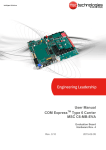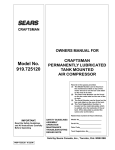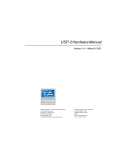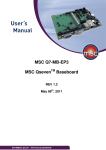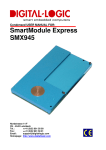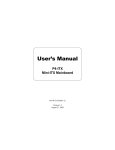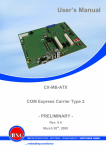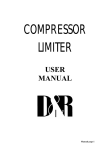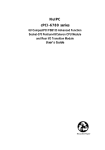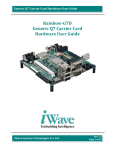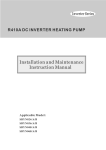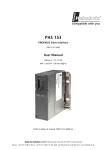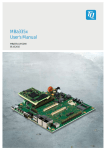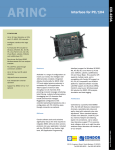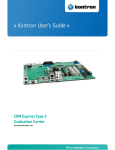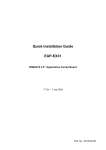Download MODBASE 210 - ELTEC Elektronik AG
Transcript
MODBASE 210 BASE BOARD FOR COM EXPRESS MODULES USER MANUAL Revision 0.2 MODBASE 210 User Manual Revision Revision Changes Date / Name 0.2 First Edition 08.11.06 dh DISCLAIMER Copyright © 2006 ELTEC Elektronik AG. The information, data, and figures in this document including respective references have been verified and found to be legitimate. In particular in the event of error they may, therefore, be changed at any time without prior notice. The complete risk inherent in the utilization of this document or in the results of its utilization shall be with the user; to this end, ELTEC Elektronik AG shall not accept any liability. Regardless of the applicability of respective copyrights, no portion of this document shall be copied, forwarded or stored in a data reception system or entered into such systems without the express prior written consent of ELTEC Elektronik AG, regardless of how such acts are performed and what system is used (electronic, mechanic, photocopying, recording, etc.). All product and company names are registered trademarks of the respective companies. Our General Business, Delivery, Offer, and Payment Terms and Conditions shall otherwise apply. Federal communications commission statement a a a a a a a a a This device complies with FCC Rules Part 15. Operation is subject to the following two conditions: This device may not cause harmful interference, and This device must accept any interference received including interference that may cause undesired operation. This equipment has been tested and found to comply with the limits for a Class B digital device, pursuant to Part 15 of the FCC Rules. These limits are designed to provide reasonable protection against harmful interference in a residential installation. This equipment generates, uses and can radiate radio frequency energy and, if not installed and used in accordance with manufacturer’s instructions, may cause harmful interference to radio communications. However, there is no guarantee that interference will not occur in a particular installation. If this equipment does cause harmful interference to radio or television reception, which can be determined by turning the equipment off and on, the user is encouraged to try correct the interference by one or more of the following measures: Reorient or relocate the receiving antenna. Increase the separation between the equipment and receiver. Connect the equipment to an outlet on a circuit different from that to which the receiver is connected. Consult the dealer or an experienced radio/TV technician for help. The us of shielded cables for connection of the monitor to the graphics card is required to assure compliance with FCC regulations. Changes or modifications to this unit not expressly approved by the party responsible for compliance could void the user’s authority to operate this equipment. Canadian department of communications statement a a This digital apparatus does not exceed the Class B limits for radio noise emissions from digital apparatus set out in the Radio Interference Regulations of the Canadian Department of Communications. This class B digital apparatus complies with Canadian ICES-003 Revision 0.2 2|2 MODBASE 210 User Manual SAFETY INFORMATION Electrical safety a a a a a To prevent electrical shock hazard, disconnect the power cable from the electrical outlet before reloading the system. When adding or removing devices to or from the system, ensure that the power cables for the devices are unplugged before the signal cables are connected. If possible, disconnect all power cables from the existing system before you add device. Before connecting or removing signals cables from motherboard, ensure that all power cables are unplugged. Make sure that your power supply is set to the correct voltage in your area. If you are not sure about the voltage of the electrical outlet you are using, contact your local power company. If the power supply is broken, do not try to fix it by yourself. Contact a qualified service technician or your retailer. Operation safety a a a a a a Before installing the motherboard and adding devices on it, carefully read the manuals that came with the package. Before using the product, make sure all cables are correctly connected and the power cables are not damaged. If you detect any damage, contact your dealer immediately. To avoid short circuits, keep paper clips, screws, and staples away from connectors, slots sockets and circuitry. Avoid dust, humidity, and temperature extremes. Do not place the product in any area where it may become wet. Place the product on a stable surface. If you encounter technical problems with the product, contact a qualified service technician or your retailer. EMC Rules This unit has to be installed in a shielded housing. If not installed in a properly shielded enclosure, and used in accordance with the instruction manual, this product may cause radio interference in which case the user may be required to take adequate measures at his or her own expense. IMPROTANT INFORMATION This product is not an end user product. It was developed and manufactured for further processing by trained personnel. RECYCLING Please recycle packaging environmentally friendly: Packaging materials are recyclable. Please do not dispose packaging into domestic waste but recycle it. Please recycle old or redundant devices environmentally friendly: Old devices contain valuable recyclable materials that should be reutilized. Therefore please dispose old devices at collection points which are suitable. Revision 0.2 3|3 MODBASE 210 User Manual TABLE OF CONTENTS MODBASE 210 ....................................................................................................................................... 1 1 General ............................................................................................................................................ 6 1.1 Revisions and Modifications ......................................................................................................... 6 1.2 Reference Documents.................................................................................................................. 6 1.3 Definitions and Abbreviations ....................................................................................................... 7 2 Introduction .................................................................................................................................... 8 2.1 Product Description ...................................................................................................................... 8 2.2 Block Diagram .............................................................................................................................. 9 2.3 Positioning of the Connectors..................................................................................................... 10 3 Mechanics ..................................................................................................................................... 11 3.1 Dimensions ................................................................................................................................. 11 4 Hardware ....................................................................................................................................... 12 4.1 Plug-in Position of the COM Express module ............................................................................ 12 4.2 PCI Slots..................................................................................................................................... 12 4.3 PCI Express x1 Slots.................................................................................................................. 13 4.4 PCI Express x16 Graphics Slot .................................................................................................. 13 4.5 VGA Interface ............................................................................................................................. 14 4.6 LVDS-Interface ........................................................................................................................... 15 4.6.1 LVDS EEPROM ............................................................................................................... 15 4.6.2 Backlight Inverter Interface .............................................................................................. 15 4.7 JILI Interface ............................................................................................................................... 16 4.7.1 Standard JILI Connector.................................................................................................. 16 4.7.2 JILI40 Connector ............................................................................................................. 16 4.8 TV Out ........................................................................................................................................ 17 4.9 Audio........................................................................................................................................... 17 4.9.1 Mono-Microphone............................................................................................................ 18 4.9.2 Stereo LineIn.................................................................................................................... 18 4.9.3 Stereo LineOut................................................................................................................. 18 4.9.4 Stereo Headphone........................................................................................................... 19 4.10 IDE Interface ........................................................................................................................... 19 4.10.1 Primary IDE Channel ....................................................................................................... 19 4.11 SATA-Interface ....................................................................................................................... 20 4.12 USB Topology......................................................................................................................... 20 4.12.1 USB Power Supply .......................................................................................................... 21 4.13 Ethernet................................................................................................................................... 21 4.14 LPC Slot .................................................................................................................................. 22 4.15 I/O Connector.......................................................................................................................... 23 4.16 GPIO ....................................................................................................................................... 23 4.17 ATX Connector ....................................................................................................................... 24 4.18 SuperIO................................................................................................................................... 24 4.18.1 COM Ports ....................................................................................................................... 24 4.18.2 IrDA.................................................................................................................................. 25 4.18.3 PS/2 ................................................................................................................................. 26 4.18.4 Fan interface .................................................................................................................... 26 4.18.5 SuperIO Hardware Monitor.............................................................................................. 27 4.19 SMB Hardware Monitor........................................................................................................... 27 4.20 Serial EEPROM at SMBus...................................................................................................... 27 4.21 Serial EEPROM at I2C-Bus .................................................................................................... 27 4.22 OnBoard BIOS-Flash .............................................................................................................. 28 4.23 POST-Code Display................................................................................................................ 28 4.23.1 Lattice Programming Interface......................................................................................... 29 4.24 Battery..................................................................................................................................... 29 4.25 Beeper..................................................................................................................................... 29 4.26 Power Button .......................................................................................................................... 29 Revision 0.2 Page 4 of 4 MODBASE 210 User Manual 4.27 4.28 Reset of the System................................................................................................................ 30 Miscellaneous ......................................................................................................................... 30 4.28.1 Measuring Resistors for current measuring..................................................................... 30 4.28.2 Ground Pins ..................................................................................................................... 30 4.28.3 Sleep State LED Display ................................................................................................. 30 ILLUSTRATIONS Illustration 1 Block Diagram Main Board ............................................................................................... 9 Illustration 2 Positioning of the Connectors ......................................................................................... 10 TABLES Table 1 Assignment PCI slot to connector reference.......................................................................... 12 Table 2 Assignment PCI Express Lane to connector reference ......................................................... 13 Table 3 Pinout VGA Interface.............................................................................................................. 14 Table 4 Pinout Single Channel LVDS-Interface .................................................................................. 15 Table 5 Pinout Backlight...................................................................................................................... 16 Table 6 Pinout TV-Out......................................................................................................................... 17 Table 7 Pinout TV-Out Pin header ...................................................................................................... 17 Table 8 Pinout Microphone.................................................................................................................. 18 Table 9 Pinout LineIn........................................................................................................................... 18 Table 10 Pinout LineOut...................................................................................................................... 18 Table 11 Pinout Headphone................................................................................................................ 19 Table 12 Assignment SATA Channel to Connector Reference .......................................................... 20 Table 13 Assignment USB Ports......................................................................................................... 20 Table 14 Pinout LPC-Slot .................................................................................................................... 22 Table 15 Pinout I/O-Connector............................................................................................................ 23 Table 16 Pinout GPIO connector ........................................................................................................ 24 Table 17 Assignment COM Ports to Connector Reference ................................................................ 25 Table 18 Pinout COM Ports ................................................................................................................ 25 Table 19 Pinout IrDA ........................................................................................................................... 25 Table 20 Pinout Upper PS/2 Jack ....................................................................................................... 26 Table 21 Pinout Lower PS/2 Jack ....................................................................................................... 26 Table 22 Pinout Fan Interface ............................................................................................................. 26 Table 23 Pinout POST Display (HP-POD) .......................................................................................... 28 Table 24 Pinout Lattice Programming Interface.................................................................................. 29 Revision 0.2 Page 5 of 5 MODBASE 210 User Manual 1 General 1.1 Revisions and Modifications Revision Date Author Comment 0.1 03.08.2006 USte Generated, German version 0.2 08.11.2006 bkae, kol Translated to English 1.2 Reference Documents [1] COM Express Module Base Specification COM Express Revision 1.0 Last update: July 10th, 2005 [2] ATX Specification atx2_21.pdf Version 2.2 http://www.formfactors.org [3] PCI Local Bus Specification Rev. 2.1 PCI21.PDF Last update: June 1st, 1995 http://www.pcisig.com [4] JILI Specification Jilim120.pdf Last update: April 7th, 2003 http://www.jumptec.de/product/data/jili/index.html [5] Digital Video Interface DVI dvi_10.pdf Rev. 1.0 April 2nd, 1999 http://www.ddwg.org/ [6] ATA/ATAPI-6 Specification d1410r3b.pdf http://www.t13.org/ [7] CF+ & CF Specification Rev. 3.0 cfspc3_0.pdf http://www.compactflash.org/ [8] Serial ATA Specification Serial ATA 1.0 gold.pdf Last update: August 29th, 2002 Rev.1.0 http://www.sata-io.org/ [9] IEEE Std. 802.3-2002 802.3-2002.pdf http://www.ieee.org [10] Universal Bus Specification usb_20.pdf Last update: April 27th, 2000 http://www.usb.org Revision 0.2 Page 6 of 6 MODBASE 210 User Manual 1.3 Definitions and Abbreviations COM RTC ATX PCI IDE EIDE CF ATA ATAPI SATA USB PEG GPIO LVDS JILI LAN VGA LPC POST SMBus MDI Revision 0.2 Computer-On-Module Real Time Clock Advanced Technology Extended Peripheral Component Interconnect Integrated Drive Electronics Enhanced Integrated Drive Electronics Compact Flash Advanced Technology Attachment Advanced Technology Attachment with Packet Interface Serial Advanced Technology Attachment Universal Serial Bus PCI express Graphics General Purpose Input / Output Low Voltage Differential Signaling JUMPtec Intelligent LVDS Interface Local Area Network Video Graphics Array Low Pin Count Power on self test System Management Bus Medium Dependent Interface Page 7 of 7 MODBASE 210 User Manual 2 Introduction 2.1 Product Description COM Express modules are compact, highly integrated Single Board Computers. Typically a COM Express module consists of CPU, chipset, memory, video controller, Ethernet controller, BIOS flash and EIDE-, SATA- and USB controller. Interface controllers (e.g. for PCMCIA) or connectors (e.g. RJ45) are implemented on the base board on to which the COM Express module can be mounted via one or two 220-pin SMD-connectors. Beside the power supply also signals for PCI Express- and PCI-bus, EIDE, SATA, USAB, LPC etc. are present on these connectors. The type of interfaces that is led from the COM Express module to the base board depends on the type of module that is used. The COM Express specification defines five different types which differ in number and pin assignment of the module connectors. Thanks to the standardized mechanics and interfaces the system can be scaled arbitrarily. Despite a modular concept the systems design is very flat and compact. COM Express modules need a base-board for successful operation. The main board described in the following acts as an evaluation board for the modules. Features a a a a a a a a a a a a a a a a a a a a a a a a Interface for COM Express module type 2 up to extended form factor 4 PCI slots 32Bit v2.1 6 PCI Express slots PCI Express x16 graphics / SDVO VGA interface LVDS interface Standard JILI / JILI40 TV-Out AC'97-Link " LineIn " LineOut " Headphone " Microphone 40 pin IDE interface Ultra ATA-100/66/33 44 pin IDE interface Ultra ATA-100/66/33 Compact flash interface Spec. v3.0 4 SATA channels up to 150MB/s 8 USB2.0 root hub interfaces LAN interface max. 1GBit LPC slot Pin header for GPIOs SuperIO W83627THF " 2x PS/2 " 2x COM " 1x IrDA " 2 fan interfaces " Hardware monitoring Power supply via ATX connector POST display on LPC Serial EEPROM on I²C-Bus Serial EEPROM on SMBus On-board BIOS Flash Beeper Revision 0.2 Page 8 of 8 Revision 0.2 PS/2 COM1 COM2 SMB IO Stecker PS/2 Erweiterungskarte LPC-Slot Port80h GPIO GPIO COM1 LPC COM2 IrDA SuperIO I²C EEPROM HW Monitor MDI HW Monitor EEPROM Lüfter Mic AC-Link AC97-Codec LineOut SMB 4x PCI-Slot PCI 6 PCIe TV-out TV-out 6x PCIe-Slot Kopfhörer COM Expressmodul LineIn 8x USB 8 USB VGA VGA A B LVDS 4x SATA 4 SATA PCIe-G PCIe Graphics IDE LVDS-I²C JILI EEPROM std. JILI JILI40 LCD CF Slot 44pol. Stecker 40pol. Stecker Backlight 2.2 Übertrager LAN MODBASE 210 User Manual Block Diagram Illustration 1 Block Diagram Main Board Page 9 of 9 MODBASE 210 User Manual 2.3 Positioning of the Connectors Illustration 2 Positioning of the Connectors Revision 0.2 Page 10 of 10 MODBASE 210 User Manual 3 Mechanics 3.1 Dimensions a a a a Dimension: Width: Tolerances of the drill holes: Tolerances of the diameter: Revision 0.2 254.5 mm x 36.8 mm 1.6 mm + /-10% +/- 0.1mm in X and Y + 0.1 mm Page 11 of 11 MODBASE 210 User Manual 4 Hardware 4.1 Plug-in Position of the COM Express module A plug-in for COM Express type 2 modules is available on the main board. Following form factors are supported: a a a Compact module (ELTEC specific format) Basic module Extended module Specification a a Reference: Connector: a Pinout: 4.2 PCI Slots X1 AMP / Tyco 3-1827233-6 0.5 mm pitch free height 440 pin 5H plug (combination of two 220pin plugs) Refer to COM Express specification for type 2 module [1] Four 32-bit PCI slots are provided according to PCI specification v2.1. The signal assignment: a a a a INTA#, INTB#, INTC# and INTD# REQ[0..3]# GNT[0..3]# IDSEL for slot 0, slot 1, slot 2 and slot 3 is defined in the COM Express specification [1] PCI Slot Reference PCI Slot 0 PCI Slot 1 PCI Slot 2 PCI Slot 3 X2 X3 X4 X5 Table 1 Assignment PCI slot to connector reference Specification a a a References: Connector: Pinout: Revision 0.2 X2 - X5 AMP / Tyco 5145154-4 Refer to PCI specification v2.1 [3] Page 12 of 12 MODBASE 210 User Manual 4.3 PCI Express x1 Slots One PCI Express x1 slot is assigned to each of the 6 PCI Express lanes of the COM Express module. PCI Express Lane References PCI Express Lane 0 X6 PCI Express Lane 1 X7 PCI Express Lane 2 X8 PCI Express Lane 3 X9 PCI Express Lane 4 X10 PCI Express Lane 5 X11 Table 2 Assignment PCI Express Lane to connector reference Specification a a a References: Connector: Pinout: X6 - X11 AMP / Tyco 4-1612163-1 Refer to PCI express specification For measuring purposes the PCI express clock is routed to test connector X54. Specification a a References: Connector: X54 Huber+Suhne 82 SMA-50-0-1/111NE(H) 4.4 PCI Express x16 Graphics Slot A PCI Express X16 graphics slot is provided as plug-in for PEG graphics cards. Depending on the chipset the PCI Express signals are multiplexed with SDVO signals, thus SDVO modules can be run in this slot as well. SDVO or PCI Express graphics will be activated automatically via PullUps of the SDVO I²C interface on the SDVO module. Specification a a a References: Connector: Pinout: Revision 0.2 X12 AMP / Tyco 4-1612163-4 Refer to PCI express specification Page 13 of 13 MODBASE 210 User Manual 4.5 VGA Interface An analog display can be connected via a VGA (VESA DDC) interface. Specification a a a References: Connector: Pinout: X13 Suyin 7507S-15G5T-A Refer to Table 3 Pin Signal name Function 1 RED Signal red 2 GREEN Signal green 3 BLUE Signal blue 4 RSVD reserved 5 GND Ground digital 6 RGND Ground red 7 GGND Ground green 8 BGND Ground blue 9 +5V +5V VDC 10 SGND Ground Synchronisation 11 ID0 Monitor ID Bit 0 (optional) 12 SDA DDC Data 13 HSYNC Horizontal Sync. 14 VSYNC Vertical Sync. 15 SCL DDC Clock Table 3 Pinout VGA Interface Revision 0.2 Page 14 of 14 MODBASE 210 User Manual 4.6 LVDS-Interface LCDs can be connected via a single channel LVDS interface: Specification a a a a References: X14 Connector: Hirose DF19G-20P-1H Pinout: Refer to Table 4 Pin 20 can be configured via 0Ohm resistors to “OPEN” or “GND” Pin Signal name Function 1 VDD Power Supply: +3.3V 2 VDD Power Supply: +3.3V 3 VSS Ground 4 VSS Ground 5 LVDS_A0- LVDS Negative data signal (-) 6 LVDS_A0+ LVDS Positive data signal (+) 7 VSS Ground 8 LVDS_A1- LVDS Negative data signal (-) 9 LVDS_A1+ LVDS Positive data signal (+) 10 VSS Ground 11 LVDS_A2- LVDS Negative data signal (-) 12 LVDS_A2+ LVDS Positive data signal (+) 13 VSS Ground 14 LVDS_A_CK- LVDS Negative clock signal (-) 15 LVDS_A_CK+ LVDS Positive clock signal (+) 16 VSS Ground 17 LVDS_A3- LVDS Negative data signal (-) 18 LVDS_A3+ LVDS Positive data signal (+) 19 VSS Ground 20 NC / VSS Reserved / Ground Table 4 Pinout Single Channel LVDS-Interface 4.6.1 LVDS EEPROM To store configuration data of the LCD, a serial EEPROM is connected to the signals LVDS_I2C_CK and LVDS_I2C_DAT. To avoid conflicts with configuration EEPROMs connected via the JILI connector, this EEPROM is socketed and can be assembled optionally. 4.6.2 Backlight Inverter Interface The supply voltage of the backlight can be adjusted with jumper JP0601. The according position is printed on the PCB. You have to set J5 depending on the backlight inverter you use. If the inverter needs a low active start signal, jumper J5 has to be set to L (pin1 connected to pin2). Revision 0.2 Page 15 of 15 MODBASE 210 User Manual If the inverter needs a high active start signal, jumper J5 has to be set to H (pin2 connected to pin3). Brightness of the backlight inverter is controlled via the LVDS-BKLT-CTRL signal. As the LVDS-BKLT-CTRL signal of the COM Express module is supplied as PWM signal by actual chipsets, this signal initially is integrated and then limited to the maximum allowable voltage of the backlight inverter via voltage divider. Control voltage: 0...3V A value of 0V corresponds to maximum brightness. Specification a a a References: Connector: Pinout: X15 Molex (53047-0510) 53261-0590 Refer to Table 5 Pin Signal name Function 1 VCC Power supply backlight 2 GND Ground 3 BLON# Backlight On 4 VCON Brightness control 5 GND Ground Table 5 Pinout Backlight 4.7 JILI Interface 4.7.1 Standard JILI Connector A standard JILI connector can be used alternatively for connection of LCDs. Both, single and dual channel LCDs, can be adapted to the main board via small additional PCBs. Specification a a a References: Connector: Pinout: X16 Hirose FH12-40S-0.5SV "standard JILI" according to JILI specification [4] 4.7.2 JILI40 Connector Any LCD display can be adapted via a JILI40 connector. Two 24 bit LVDS channels are present on this 40-pin header Specification a a a References: Connector: Pinout: Revision 0.2 X46 Samtec TMM-120-01-LM-D-SM-P "JILI40" according to JILI specification [4] Page 16 of 16 MODBASE 210 User Manual 4.8 TV Out A TV-OUT connector is implemented for displaying the video signal on a TV set (or the like). The main board supports the following video signals a Composite Video a Component Video (YPbPr) a S-Video The type of the video signal is defined by the graphics controller on the COM Express module. Specification a a a References: Connector: Pinout: X17 AMP 5786766-1 Refer to Table 6 Pin Signal name Composite Component S-Video 1 TV_IRTN_B Ground Ground Ground 2 TV_IRTN_C Ground Ground Ground 3 TV_DACB not used Luminance (Y) Luminance 4 TV_DACC not used Chrominance (Pr) Chrominance 5 TV_DACA CVBS Chrominance (Pb) not used 6 TV_IRTNA Ground Ground Ground 7 RSVD reserved reserved reserved Table 6 Pinout TV-Out The signals can be adapted to another connector with a 10-pin header. Specification a a a References: Connector: Pinout: X53 IDC-M 10pol. THT RM2.54 Refer to Table 7 Pin Signal Pin Signal 1 GND 2 TV_DACA 3 GND 4 TV_DACB 5 GND 6 TV_DACC 7 GND 8 GND 9 GND 10 GND Table 7 Pinout TV-Out Pin header 4.9 Audio An AC’97 codec V2.2 is connected to the AC link of the COM Express module. Footprint and circuit are compatible to following AC’97 codecs: a a VIA VT1612A Realtek ALC650 Revision 0.2 Page 17 of 17 MODBASE 210 User Manual Following NF signals are provided by the AC’97 codec: a a a a Mono Microphone Stereo LineIn Stereo LineOut Stereo Headphone 4.9.1 Mono-Microphone Bias voltage for capactior microphones is provided. Specification a a a References: Connector: Pinout: X18 Kycon ST-3000 Refer to Table 8 Pin Signal name Function 1 GND Ground 2 MIC_BIAS Bias initial load (ring) 3 MIC NF signal (tip) Table 8 Pinout Microphone 4.9.2 Stereo LineIn Specification a a a References: Connector: Pinout: X19 Kycon ST-3000 Refer to Table 9 Pin Signal name Function 1 GND Ground 2 LINEIN_R NF signal right (ring) 3 LINEIN_L NF signal left (tip) Table 9 Pinout LineIn 4.9.3 Stereo LineOut Specification a a a References: Connector: Pinout: X20 Kycon ST-3000 Refer to Table 10 Pin Signal name Function 1 GND Ground 2 LINEOUT_R NF signal right (ring) 3 LINEOUT_L NF signal left (tip) Table 10 Pinout LineOut Revision 0.2 Page 18 of 18 MODBASE 210 User Manual 4.9.4 Stereo Headphone Specification a a a References: Connector: Pinout: X21 Kycon ST-3000 Refer to Table 11 Pin Signal name Function 1 GND Ground 2 HPOUT_R NF signal right (ring) 3 HPOUT_L NF signal left (tip) Table 11 Pinout Headphone 4.10 IDE Interface A standard IDE interface is provided according to ATA/ATAPI, with the controller supporting at least Ultra-ATA100 with 100 MB/sec data rate. The transfer mode that can be selected depends on how the system is wired and which modes are supported by the drives. 4.10.1 Primary IDE Channel 4.10.1.1 40-pin IDE interface A 40-pin IDC connector is provided at the primary IDE channel for standard IDE drives. Specification a a References: Connector: Pinout: X22 FCI 75869-118 Refer to Specification ATA/ATAPI-6 Source [6], page 400, Table A3 4.10.1.2 44-pin IDE Interface For connection of 2.5” hard disks, a 44-pin IDC connector is provided at the primary IDE channel. Specification a a a References: Connector: Pinout: X23 Yamaichi ZP7-44-S-G Refer to Specification ATA/ATAPI-6 Source [6], page 412, Table A16 4.10.1.3 Compact Flash Interface A socket for compact flash cards, type I/II, is provided at the primary IDE channel. The compact flash interface supports True IDE mode according to compact flash specification rev. 3.0. Inter alia the compact flash specification rev. 3.0 supports the UDMA mode. Specification a a a References: Connector: Pinout: Revision 0.2 X24 Yamaichi CF050P2-003-10-D2 Refer to specification "CF+ & CF specification rev. 3.0" Source [7] , page 24, table 4 Page 19 of 19 MODBASE 210 User Manual 4.11 SATA-Interface For SATA drives four connectors are populated with SATA interface (signals + power). Every SATA signal connector has its own power supply connector. SATA Channel References SATA 0 X25 SATA 1 X26 SATA 2 X27 SATA 3 X28 Table 12 Assignment SATA Channel to Connector Reference Specification SATA signal connector a a a References: Connector: Pinout: X25 - X28 Molex 87713 series Refer to Specification SATA Source [8], page 46, table 3 Specification Power Supply a a a References: Connector: Pinout: X49 - X52 AMP 171825-4 Refer to ATX specification v2.2 [2]; "Floppy Drive Power Connector" 4.12 USB Topology Eight USB ports are provided by the COM Express module. The exact assignment of each port is defined in the following table: USB-Port References Description USB0 X29 External dual connector 1 USB1 X29 External dual connector 1 USB2 X30 External dual connector 2 USB3 X30 External dual connector 2 USB4 X31 External dual connector 3 USB5 X31 External dual connector 3 USB6 X32 External dual connector 4 USB7 X32 External dual connector 4 Table 13 Assignment USB Ports Revision 0.2 Page 20 of 20 MODBASE 210 User Manual 4.12.1 USB Power Supply The power supplies are protected by USB power switches. In addition to that the input voltages of the USB power switches are protected by resetable fuses. The USB power switches have the following functions: a a a a a a The output current is limited to 500mA per port A signal to detect overcurrent is generated for each two ports USB0 and USB1 have one common signal to detect overcurrent USB2 and USB3 have one common signal to detect overcurrent USB4 and USB5 have one common signal to detect overcurrent USB6 and USB7 have one common signal to detect overcurrent Specification a a a References: Connector: Pinout: 4.13 Ethernet X29 - X32 AMP 787617-2 (Dual USB connector type A) according to USB specification 2.0 [10] The mainboard can be connected to a local area network with an ethernet interface. The COM Express module already provides MDI signals, so that there is only the transformer on the mainboard required. The transformer PULSE H 5004 not only supports 10BaseT and 100BaseTX but also 1Gbit. Specification a a a References: Connector: Pinout: Revision 0.2 X33 AMP 2-406549 Refer to IEEE Std. 802.3 [9], section three, page 225 Page 21 of 21 MODBASE 210 User Manual 4.14 LPC Slot You have an LPC slot available to insert extension board with LPC interface. Specification a a a References: Connector: Pinout: X34 36-pin header, 2.54mm Refer to Table 14 Pin Signal Pin Signal 1 VCC5V 2 VCC5V 3 NC 4 VCC3V3 5 VCC3V3 6 NC 7 VCC3V3_SBY 8 GND 9 GND 10 LPC_RST# 11 GND 12 LPC_LAD0 13 LPC_LAD1 14 LPC_LAD2 15 LPC_LAD3 16 LPC_FRAME# 17 GND 18 LPC_DRQ0 19 GND 20 LPC_CLK 21 GND 22 LPC_PWRDWN 23 GND 24 PME# 25 GND 26 LPC_SMI# 27 GND 28 SERIRQ 29 GND 30 PCI_CLKRUN# 31 GND 32 CPU_RST# 33 GND 34 LPC_DRQ1# 35 GND 36 GND Table 14 Pinout LPC-Slot Revision 0.2 Page 22 of 22 MODBASE 210 User Manual 4.15 I/O Connector An alternative SuperIO controller can be integrated via a 36-pin connector. In this case the onboard chip is not populated and a piggy back board with the SuperIO chip is plugged into the I/O and into the LPC connector. Specification a a a References: Connector: Pinout: X45 CAB 1002-161-036 Refer to Table 15 Pin 1 3 5 7 9 11 13 15 17 19 21 23 25 27 29 31 33 35 Signal SMB_CLK SMB_DAT KBDAT KBCLK MSDAT MSCLK NC NC NC NC COM1_DCD# COM1_RXD COM1_TXD COM1_DTR# COM1_DSR# COM1_RTS# COM1_CTS# COM1_RI# Pin 2 4 6 8 10 12 14 16 18 20 22 24 26 28 30 32 34 36 Signal SLP_S3# SLP_S4# SLP_S5# EXT_THRM# SMBALERT# NC THRMTRIP# BATLOW# NC NC COM2_DCD# COM2_RXD COM2_TXD COM2_DTR# COM2_DSR# COM2_RTS# COM2_CTS# COM2_RI# Table 15 Pinout I/O-Connector 4.16 GPIO The COM Express module provides four general purpose outputs and four general purpose inputs. The GPIs have PullUp resistors and are routed to a dip switch (SW1103). With the dip switch the GPIs can be connected to ground. The assignment GPI – switch – level is printed on the PCB. If the PullUp resistors are not populated, you can switch LPC_SMI# or HWM_SMI# to GPI0, GPI1, GPI2 or GPI3 with jumper JP1101. The GPOs are connected to LEDs to optically display the status. Revision 0.2 Page 23 of 23 MODBASE 210 User Manual Specification a a a References: Connector: Pinout: X35 CAB 1002-161-036 Refer to Table 16 Pin Signal Pin Signal 1 GPI0 2 GND 3 GPI1 4 GND 5 GPI2 6 GND 7 GPI3 8 GND 9 GPO0 10 GND 11 GPO1 12 GND 13 GPO2 14 GND 15 GPO3 16 GND Table 16 Pinout GPIO connector 4.17 ATX Connector An ATX connector with additional ATX12V connector is available for power supply of the system. Specification ATX connector a a a References: Connector: Pinout: X36 Molex 44206-0007 Refer to ATX specification v2.2 [2] Specification ATX12V connector a a a References: Connector: Pinout: 4.18 SuperIO X37 Molex 39-29-9042 Refer to ATX specification v2.2 [2] The Winbond SuperIO W83627THF is integrated on the base board. Interfaces used by the SuperIO a 2 RS232 interface (function of COM port shared with IrDA interface) a 1 IrDA interface (function shared with COM port) a PS/2 interface for keyboard and mouse a 2 fan interfaces a 4 voltage control a 1 temperature control 4.18.1 COM Ports Characteristics of the COM ports a a a RS232 standard RS232 transceiver ESD protected +/- 15kV EMC improvement by using EMI filters in the signal lines Revision 0.2 Page 24 of 24 MODBASE 210 User Manual The exact assignment of each single port to the connector reference can be seen from the following table: COM Port References COM 1 X38 COM 2 X39 Table 17 Assignment COM Ports to Connector Reference Specification a a a References: Connector: Pinout: X38 and X39 Weitronic 107-091-10-10-10 Refer to Table 18 Pin Signal name Function 1 DCD# Data Carrier Detect 2 RXD Receive Data 3 TXD Transmit Data 4 DTR# Data Terminal Ready 5 GND Ground 6 DSR# Data Set Ready 7 RTS# Request To Send 8 CTS# Clear To Send 9 RI# Ring Indicator Table 18 Pinout COM Ports 4.18.2 IrDA The connectors of the IrDA interface are designed for commercial IrDA transmitters. Specification a a a References: Connector: Pinout: X40 CAB 1001-161-005 Refer to Table 19 Pin Signal name Function 1 +5V Power supply 2 NC Not connected 3 IRRX Received data 4 GND Ground 5 IRTX Transmission data Table 19 Pinout IrDA Revision 0.2 Page 25 of 25 MODBASE 210 User Manual 4.18.3 PS/2 You have a double PS/2 connector for PS/2 keyboards and PS/2 mice. The upper jack only supports PS/2 mice. The pins of the lower jack provide both, signals for PS/2 keyboards and those for PS/2 mice. Keyboards can be connected directly, mice can only be operated using an according Y-adapter. Specification a a a References: Connector: Pinout: X41 Tyco 84376-1 Refer to Table 20 and Table 21 Pin Signal name Function 1 MSDAT Mouse Data 2 NC not connected 3 GND Ground 4 +5V VCC 5 MSCLK Mouse Clock 6 NC not connected Table 20 Pinout Upper PS/2 Jack Pin Signal name Function 1 KBDAT Keyboard Data 2 MSDAT Mouse Data 3 GND Ground 4 +5V VCC 5 KBCLK Keyboard Clock 6 MSCLK Mouse Clock Table 21 Pinout Lower PS/2 Jack 4.18.4 Fan interface Two PWM controlled fan interfaces are integrated on the mainboard. They are located near the COM Express modul. Evaluation of the tacho signal and control of the revolution speed is done by the SuperIO. Specification a a a References: Connector: Pinout: X42 - X43 Molex 22-04-1031 Refer to Table 22 Pin Signal name Function 1 GND Ground 2 PWM PWM signal 3 TACHO Tacho signal Table 22 Pinout Fan Interface Revision 0.2 Page 26 of 26 MODBASE 210 User Manual 4.18.5 SuperIO Hardware Monitor You can check different voltages and temperatures on the hardware monitor that is integrated in the SuperIO. Monitored voltages a a a a VBAT 3.3V 12V 5V Measured temperatures a Ambient temperature The temperature is measured with a thermistor. 4.19 SMB Hardware Monitor In addition to the SuperIO hardware monitor you can also connect a SMBus hardware monitor. This chip enables you to control different voltages, temperatures and revolution speeds in legacy-freedesigns where the SuperIO is not supported. Hardware monitor: a Winbond W83L786R Controlled voltages a a a a VBAT 3.3V 12V 5V Measured temperatures a Ambient temperature The temperature is measured with a thermistor. Fan interface For evaluation and control of the revolution speeds please refer to chapter 4.17.4. 4.20 Serial EEPROM at SMBus For testing purposes a serial EEPROM (4kBit) is connected to the SMBus. To avoid address conflicts, the address can be selected with dip switch SW1101. 4.21 Serial EEPROM at I2C-Bus For testing purposes a serial EEPROM (4kBit) is connected to the I²C bus. To avoid address conflicts, the address can be selected with dip switch SW1102. Revision 0.2 Page 27 of 27 MODBASE 210 User Manual 4.22 OnBoard BIOS-Flash There is a PLCC32 socket on the mother board, where an additional firmware hub can be inserted. To boot this from firmware hub, the firmware hub on the COM Express module has to be switched off. 4.23 POST-Code Display For debugging purposes an POST code display is implemented on the main board, thus enabling the display of BIOS outputs on IO-port 80h and/or Port 90h. In addition to that these signals are output on a pin header. For protocolling purposes a logic analyser can be connected here. The pinout of the output connector X44 corresponds to the pinout of the Hewlett Packard HP-PODs. Specification a a a References: Connector: Pinout: X44 20-pin header 2.54mm Refer to Table 23 Pin HP-POD Function Pin HP-POD Function 1 +5V not used 2 CLK2 LPC_CLK 3 CLK1 not used 4 D15 not used 5 D14 not used 6 D13 Test signal 3 7 D12 Test signal 2 8 D11 Test signal 1 9 D10 Test signal 0 10 D9 not used 11 D8 Strobe 12 D7 Data 7 13 D6 Data 6 14 D5 Data 5 15 D4 Data 4 16 D3 Data 3 17 D2 Data 2 18 D1 Data 1 19 D0 Data 0 20 GND Ground Table 23 Pinout POST Display (HP-POD) Revision 0.2 Page 28 of 28 MODBASE 210 User Manual 4.23.1 Lattice Programming Interface A connector used to program the PLD to decode the POST codes is implemented. To reprogram the PLD a Lattice programming adapter is required. Specification a a a References: Connector: Pinout: X47 CAB 714-91-164-31-007 (socket) Refer to Table 24 Pin Signal name Function 1 VCC Power Supply 2 SDO_TDO Serial Data Out 3 SDI_TDI Serial Data In 4 ISPEN# Programming Enable 5 KEY Keypin 6 MODE_TMS Programming Mode 7 GND Ground 8 SCLK_TCK Serial Clock Table 24 Pinout Lattice Programming Interface 4.24 Battery The RTC on the COM Express module is buffered with a socketed battery on the main board. To be able to clear the CMOS memory, the battery voltage is connected via jumper J1101 to the COM Express module. Type of battery: 2032 Battery socket: Renata SMTU2032-1 4.25 Beeper A piezo signal generator is implemented for acoustic signals. Type: Digisound F/DGX05P 4.26 Power Button For switching the system on a Power push button has been implemented. The PWR_BTN# signal is low-active and is connected directly to the corresponding pin of the COM Express module. Type: C&K JTP-1230F Revision 0.2 Page 29 of 29 MODBASE 210 User Manual 4.27 Reset of the System You have a special push button to reset the system. The RESET# signal is low-active and is connected to the SYS_RESET#- pin of the COM Express module. Type: C&K JTP-1230F 4.28 Miscellaneous 4.28.1 Measuring Resistors for current measuring Measuring resistors are inserted into the power supply lines of the COM Express module, the PCI express graphics slot as well as into every single PCI slot and into one PCI express x1 slot. In addition to these resistors there is one jumper each to be able to measure the current using a wire loop and a clamp meter. 4.28.2 Ground Pins There are several ground pins all over the main board for connection of measuring instruments. 4.28.3 Sleep State LED Display The ELTEC MODBASE 210 has 3 LEDs to display the SleepStates. LED1201 displays status S3 LED1202 displays status S4 LED1203 displays status S5 Revision 0.2 Page 30 of 30






























